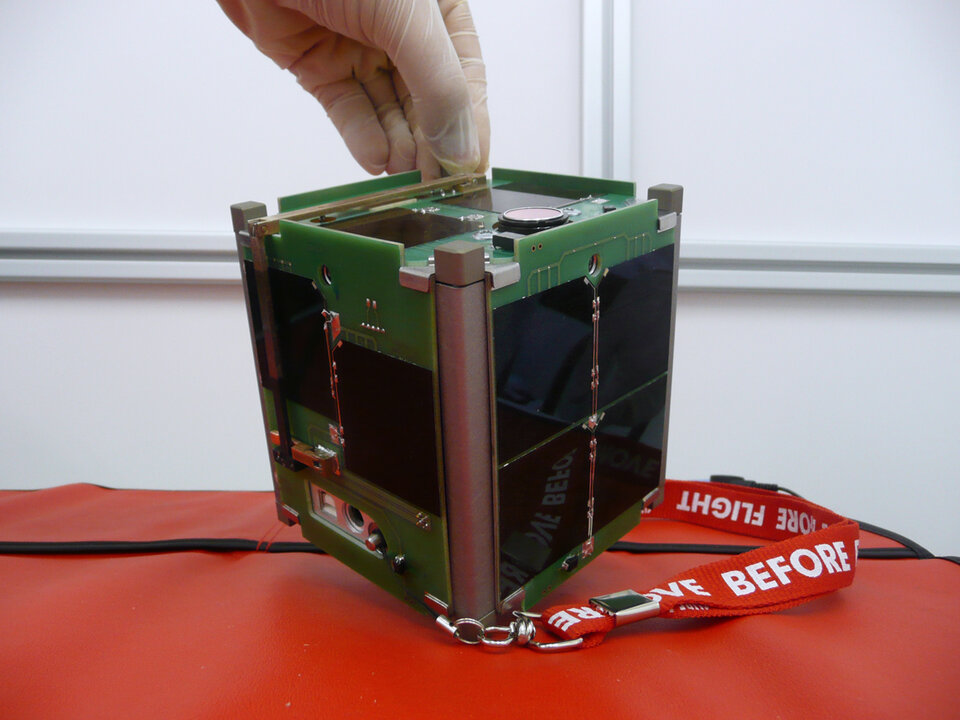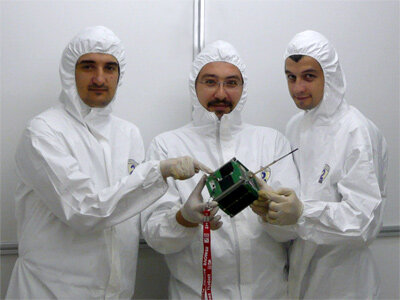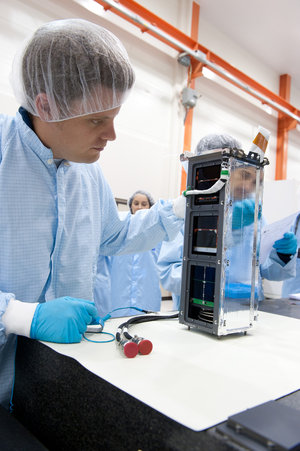Meet the teams: Goliat
Seven teams of university students were selected to fly their CubeSats on the maiden flight of ESA's Vega launch vehicle. Here is an introduction to Goliat, the Romanian team.
| Universities | University of Bucharest, Polytechnic University of Bucharest, Romanian Space Agency, Romanian Institute of Space Science, Romania |
| Endorsing professors |
Dr. Marius-Ioan Piso, Romanian Space Agency Prof. Mircea Rusu, University of Bucharest |
| Team | Mugurel Bălan, Marius Truşculescu, Claudiu Drăgăşanu, Alexandru Pandele, Iulian Buşu, Corina Dumitru, Lorand Istvan, Marian Mogîldea, George Mogîldea, Claudiu Ştirbei, Irina Ştefănescu |

The Goliat picosatellite project was built around the first year university team that flew a microgravity experiment during the ESA Parabolic Flight Campaign. The objective to develop a microsatellite mission was already included in the national space programme. The Romanian Space Agency and the Romanian Institute of Space Science provided the team with institutional, technological and financial support through a national grant.
Goliat carries three experiments for scientific measurements and Earth observation:
CICLOP is a 3 megapixel digital camera with a custom-built lens for Earth observation, particularly imaging of Romanian territory.
SAMIS is an impact sensor which will count micrometeoroid impact events and measure their energy (voltage over time) in order to estimate their number and speed. The data on each impact will be processed at the ground station.
- DOSE-N is a detector designed to measure the total dose of radiation inside the satellite. The data set will consist of a value for the dose and the position (including time) where that value was measured.
Once the early operations phase is completed, the team will start to receive and analyse the data. SAMIS and DOSE-N will increase knowledge about the radiation and micrometeoroid environments in low Earth orbit. CICLOP will test the possibility of using picosatellites to monitor surface features for agricultural, administrative and disaster monitoring purposes, as well as for public outreach. The images will be acquired at specific locations and published on the project website.
The development of Goliat involved all of the stages of a typical space mission: design, construction, integration, analysis and testing. The team also developed the ground infrastructure required for radio communication and for operating the satellite.
The CubeSat experience

How did the team members deal with the experience of CubeSat selection, design, construction, testing and integration?
"The team had to provide extensive documentation in order to validate the good functionality of the satellite and its adherence to CubeSat standards and Vega imposed mission requirements. Since one of the main objectives of the Goliat project was educational, the work process included courses, training and 'hands on' work. Supported by technical staff from the Romanian Space Agency and ESA, we were able to learn and develop our professional capabilities while meeting the project timeline.
"The project was a great opportunity for students to learn the practices involved in developing space systems. All of them greatly appreciated the knowledge and skill acquired by being involved in all the stages of the satellite development. Hands-on experience is obviously the most efficient method in assimilating new information."















 Germany
Germany
 Austria
Austria
 Belgium
Belgium
 Denmark
Denmark
 Spain
Spain
 Estonia
Estonia
 Finland
Finland
 France
France
 Greece
Greece
 Hungary
Hungary
 Ireland
Ireland
 Italy
Italy
 Luxembourg
Luxembourg
 Norway
Norway
 The Netherlands
The Netherlands
 Poland
Poland
 Portugal
Portugal
 Czechia
Czechia
 Romania
Romania
 United Kingdom
United Kingdom
 Slovenia
Slovenia
 Sweden
Sweden
 Switzerland
Switzerland




























